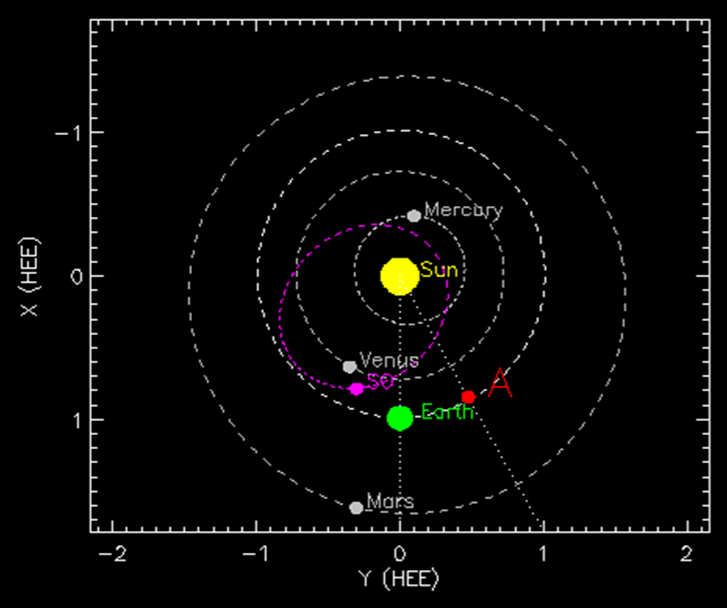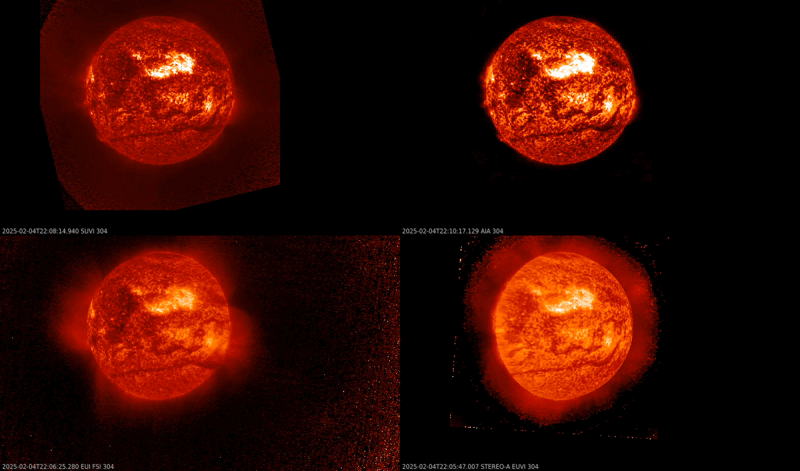Solar activity was enhanced during the first week of February. As already written in an earlier newsitem, a flock of sunspots was the source of numerous M-class flares. Yet many of the coronal mass ejections (CMEs) observed during that time were not only associated with flaring activity from that sunspot nest. The CMEs observed during e.g. the period from 2 till 5 February could also be linked to eruptive activity from other sunspot regions, from filament eruptions, from active regions at or just behind the solar limb, or from the Sun's farside. That's a whole menu, in just a few days!

The imagery above shows for this 4-day period the GOES/SUVI 304 imagery (orange; temperatures around 80.000 degrees), with the SOHO/LASCO C2 coronagraphic imagery (white light) overlaid to show the CMEs. Note that, in this case, the colors of the coronagraphic imagery have been inverted (the usually bright structures are now dark and vice versa) to bring out the fainter details. The 40-second clip contains almost 480 images (per series), thus based on 1 image every 12 minutes for 4 days. Some of the CMEs can literally be traced back to the sunspot nest (the big white structure slightly above the middle in the SUVI 304 images), while other CMEs such as the big CME on 4 February to the north lacking any apparent disk signature, meaning they are linked to farside events. Most of the CMEs visible in the clip did not have an earth-directed component, and for the few that did, it was guessing work if -a few days later- they left a signature in the solar wind parameters or not.

GOES/SUVI was of course not the only instrument observing the Sun. Also SDO, STEREO-A and Solar Orbiter were keeping an eye on our star. Whereas Solar Orbiter is currently trailing the Earth by 21 degrees, STEREO-A is 29 degrees ahead of the Earth. This can be seen in the scheme above (for 4 February), with "SO" being Solar Orbiter, "A" meaning STEREO-A, and SDO and GOES in a geotationary orbit close to Earth. Adding to this is the different field-of-view for each of the instruments, with the one for SDO/AIA the smallest (1.3 solar radii), STEREO-A/EUVI and GOES/SUVI a bit wider at 1.7 solar radii, and the one for Solar Orbiter (FSI: Full Sun Imager) the largest with a whopping 14.3 solar radii at the distance Sun-Earth.

The effect of these differences is illustrated in the next two examples. The first one (above) shows the partial eruption of a filament in the southern solar hemisphere early on 5 February. Using the "multiview" option of the Space Weather JHelioviewer (SWHV), one can combine the different views of the 4 spacecraft in a single frame, with GOES/SUVI in the upper left, SDO/AIA in the upper right, SolO/FSI in the lower left, and STEREO-A/EUVI in the lower right. All images are in the 30.4 nm passband (304 Angstrom) with the off-disk somewhat enhanced, explaining the noise in some of the images. For STEREO-A, the eruption is taking place close to its central meridian (nearly heads-on), whereas for Solar Orbiter the eruption happens close to its west limb.
In the second example (below), a jet-like eruption takes place near the Sun's east limb as observed by all 4 spacecraft around noon on 5 February. Because of the size of the event, SDO misses nearly all the good stuff from this eruption, GOES/SUVI records some of the fun, whereas Solar Orbiter's view captures the entire event in its full size (with room to spare, but not shown here). STEREO-A has a quite oblique view, making the jet-like eruption look quite smaller (fit in field-of-view!) and different than in the other instruments.

In the above multiviews, one may notice that the Sun is not looking nicely circular in the SolO and STEREO-A images. This is because JHelioviewer -in multiview mode- automatically rotates their images to make them look as if seen from the Earth (the option chosen here). This can be seen from the details on the solar disk such as e.g. the sunspot complex and the filaments that are nicely aligned for all 4 instruments, despite the quite different vantage points. The imagery underneath shows the single, non-rotated view of the jet-like eruption by Solar Orbiter. At its maximum height, the structure towered over 700.000 km above the solar limb, that is close to twice the Earth-Moon distance!






